Cold Process Cucumber Soap Recipe (Palm Free)
This cooling creamy palm free cucumber soap recipe is naturally colored with powerful French green clay and is perfect for those with overheated, itchy, or sweaty skin!

This cold process cucumber soap is a palm-free alternative to my original Cucumber Borage Soap.
When creating this recipe, I started with my standard base of skin loving olive oil, plus a generous amount of coconut oil for great lather and hardness. (If you’re allergic to coconut, try using babassu oil instead.)
I then added some rice bran oil, since I’ve really been loving it in my soaps lately – it’s a nourishing oil, rich in vitamin E, and makes a great stand-in for some of the olive oil in a recipe.
Avocado oil contains essential fatty acids, while shea butter adds moisturizing properties and a bit of extra firmness that’s often needed in palm-free recipes. If you don’t have shea butter, or are allergic, try using mango or avocado butter instead.
French green clay adds a pale green color and combines with cucumber puree to make this bar extra soothing, and great at calming itchy or inflamed skin.
I used the lye calculator at Bramble Berry to determine lye amount for a 6% superfat. (Running it by my other favorite calculator at Majestic Mountain Sage though, it results in around a 7.5% superfat, so adjust to your preference.)
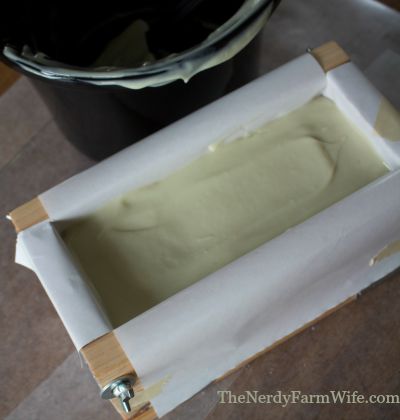
For the majority of soap recipes on this site (and in my ebook – Handmade Natural Soaps), I use a homemade wooden loaf mold (inner dimensions are 8″ x 3.5″ x 3.5″) or this silicone Crafter’s Choice loaf mold from Amazon.
If using silicone molds, reduce the liquid by around 1/2 ounce so soap will firm up faster. You may also wish to add 1 teaspoon sodium lactate to the cooled lye solution to make the bar harder & unmold more easily.
You could also try using a sturdy shoe box or empty milk carton, lined with an inexpensive, unscented trash bag, to make a disposable mold.
You can buy lye (sodium hydroxide) on Amazon.
Superfat is 6%. All measurements are by weight. You need an accurate digital scale to make soap.
- 1/4 (2 or 3 oz) of a cucumber, unpeeled
- 9 oz (255 g) cool or chilled water
- 3.83 oz (108 g) lye (sodium hydroxide)
- 1/2 tbsp French green clay
- optional: 1 tsp sodium lactate
- 12 oz (340 g) olive oil
- 8 oz (227 g) coconut oil (*or babassu oil)
- 4 oz (113 g) rice bran oil
- 2 oz (57 g) avocado oil
- 2 oz (57 g) shea, mango or avocado butter
*Note: If using babassu oil instead of coconut oil, use 3.57 ounces (101 grams) of lye for a 6% superfat.
If you haven’t made soap before, read through my Soap Making 101 post before proceeding or check out my Handmade Natural Soaps eBook Collection:
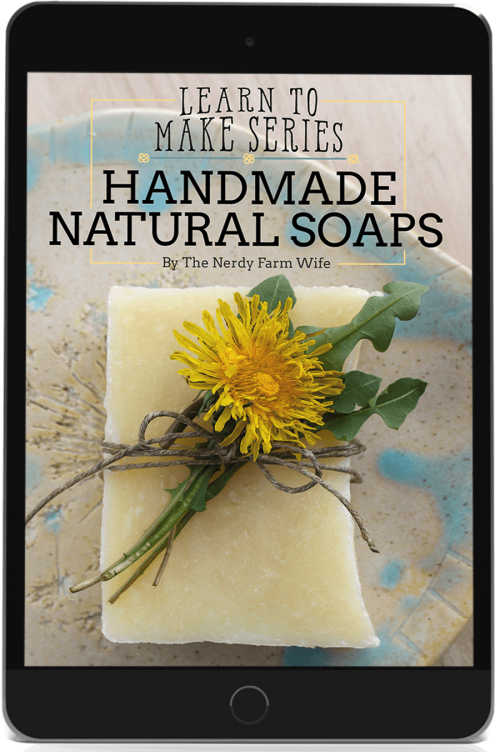
Step 1: Puree the cucumber with around 2 ounces of the chilled water. Strain. Pour the fresh cucumber juice into a heat proof plastic or stainless steel pitcher or container and add enough water, until it weighs 9 ounces (255 g).
Step 2: Wearing safety goggles, gloves and long sleeves, weigh out the lye and pour it into the pitcher of cucumber juice and water. Stir well to make sure the lye is fully dissolved. It will heat up quickly and give off strong fumes that you should avoid breathing in directly. Stir the French green clay into the lye solution and mix well.
I like to do this step in my kitchen sink, in order to contain any spills or splashes. Set the solution aside in a safe place, out of the reach of children and pets, and let cool for about 30 to 40 minutes. The temperature should drop to around 100 to 110°F (38 to 43°C) during that time. (If using sodium lactate, add once the lye solution cools.)
Step 3: Weigh the coconut oil and shea butter into a small saucepan or double boiler. Melt gently over low heat, keeping a close eye on it. Weigh the other oils into your soap making pot or container and then pour the melted oils into there too. The melted oils should bring the temperature up to around 90 to 100°F (32 to 38°C), though you don’t have to get too hung up on trying to make the temperatures match.
Step 4: Now, you’re ready to mix! Working carefully and still with gloves, goggles and long sleeves on, pour the lye solution into the oils. Stir by hand for around 30 seconds then begin mixing with an immersion (stick) blender. Do not use a hand mixer – you want a stick blender that looks like THIS.
Step 5: Blend for 5 to 10 seconds, then hand stir with the motor off for 20 to 30 seconds. Alternate until trace is reached. “Trace” means that your soap batter has gotten thick enough so that when you drizzle some of it across the surface of itself, it leaves an imprint or “tracing” before sinking back in.
Step 6: If you also want to add essential oil for scent, do so now.
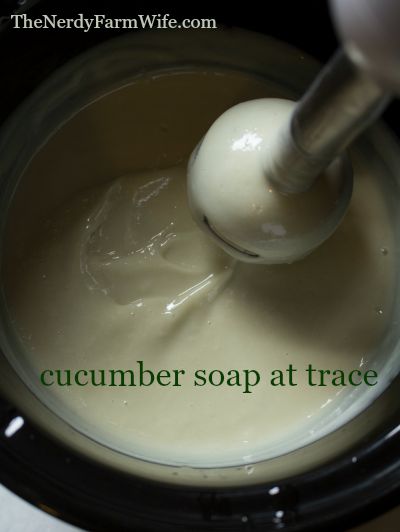
Step 7: Pour the soap into the prepared mold and cover with a sheet of wax paper, then the mold’s top or a piece of cardboard. Insulate the mold with a towel or small quilt, but peek every so often to make sure that the soap isn’t overheating. It will darken in spots and take on a gel-like appearance at some points (that’s all normal as it goes through “gel phase”), but if you see a crack developing down the middle, it’s getting too hot and should be uncovered.
Step 8: Allow the soap to stay in the mold for at least 24 to 48 hours. Remove from the mold and slice into bars. This recipe yields around 8 bars of soap. Let the soap cure for at least 4 weeks before use.
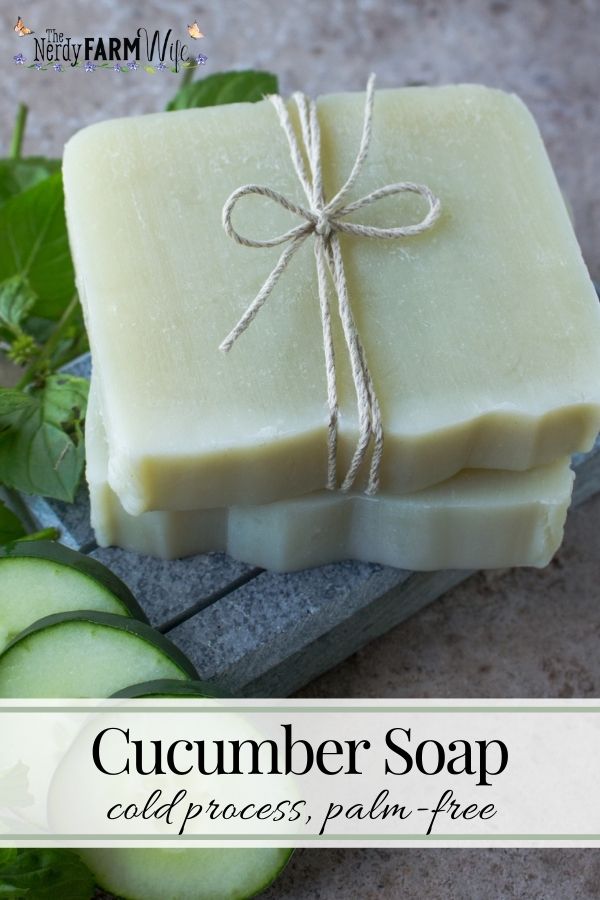

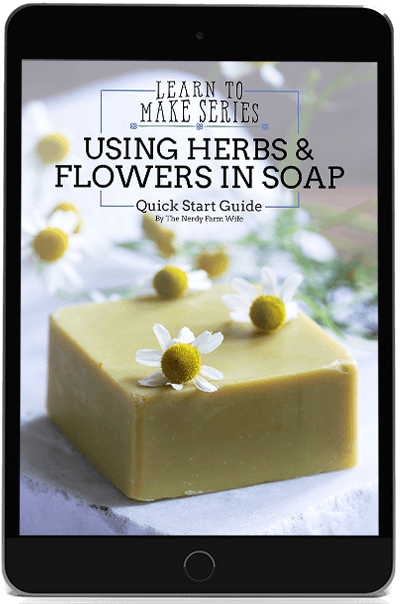

Hi Jan,
I still haven’t figured out what the shelf life is for homemade soap and this one has food, Does this soap need to be used up quickly or can it be on the shelf for awhile? Thank you.
Hi Annie R! Shelf life will vary a lot depending on the quality of your oils, how high you superfat (too many extra oils will spoil sooner) and how your soap is stored. I have some bars my mother-in-law made me years ago and they are still in great shape! I grabbed some olive oil in a pinch from my local grocery store a while back and had the soaps I made from that start developing DOS (dreaded orange spots, or signs of rancidity) before they had even cured well! High quality oils are a must for long lasting soap. You can also add vitamin E or rosemary antioxidants to slow down the oxidation process. Because soap has a high pH, food added as juices or purees will be preserved just fine. (You don’t want to put actual chunks of food items in soap though.) Your soap shouldn’t mold or anything like that, it goes bad when it gets rancid.
Thank you!! I’m getting that Rice Bran oil from Bramble Berry Monday and after reading so many of your blog post, I am regretting the few oils I purchased from Amazon. The expiration date on those go into 2017. Do you sell your soap? If you do sell, do you warn your clients to watch out for DOS? My calendula which is now a week old and still doing fine, will be the first homemade soap I’ve ever used. I have been using Zum Bar soap for years but not too crazy for them anymore.
Hi Annie R! I do sell soap from time to time, but generally DOS isn’t going to be a huge problem once you get your recipe all perfected and spend some time observing how it acts for you over a period of 6 months to a year. You can save back a bar of your homemade calendula soap and cut it in half or thirds and reserve those pieces to test/use in several month increments down the road. That will give you a good idea of how it will do for others too! :)
You cucumber soap recipe sounds so wonderful! So glad to hear your find out lye calculator so helpful! =) Thank you for the link love.
Thanks Anne-Marie!
Hi Jan,
I am interested making soap but I don’t know where to get the ingredients. Please are you able to give me a very simple recipe for me to try and make a soap?
Kind regards
Yolanda
Hi Yolanda! You could start with just olive oil and coconut oil from your grocery store and make a recipe like this:
https://thenerdyfarmwife.com/oatmeal-honey-soap-recipe-palm-free-gluten-free/
You will need lye (sodium hydroxide) which you can buy from Amazon – there should be links in most of my recipes to the one I use and like – or you could check local feed and hardware stores and they might have some too.
Make sure that you read through the Soap Making 101 post:
https://thenerdyfarmwife.com/soap-making-101-making-cold-process-soap/
Good luck with your soap making adventures! :)
TL;DR First recipe of my life, thanks so much! I touched a decent amount of trace, nothing happened. Did I do something wrong or will the soap come out fine?
I’ve just started soap making and this was the first recipe I tried! I finished the CP last evening and it’s been sitting insulated on a rack. Looks pretty good!
I’ve been doing some research and I’ve read differing and conflicting things. My understanding is that concoction should be caustic through trace and saponification, at the very least. Some people say it’ll stay [somewhat] caustic until fully cured, others say that the lye ceases to be active after 36-48 hours.
I happened to get some of the mixture, from trace, on my skin and didn’t feel any burn or itch or anything like that. I washed my hands shortly after, but I didn’t rush to the sink. It was on my skin for about a minute at most. No red marks either. I also touched the hardened soap a bit this morning and nothing. It seems strange to me that I had no reaction given my understanding. I know the soap gelled and seems to have been a success, but I can’t help but wonder if I did something wrong.
Thanks for being you! Keep on truckin’
Hi Lawrence, Hooray on making your first batch of soap! Since you wrote this a few days ago, how is it doing now? It sounds like you did everything right and it should turn out great! From what I understand, almost all of the soap is saponified within the first 24 hours. The reason we let soap cure so long is to let that last little bit happen (which still doesn’t take TOO long) and to let moisture evaporate out so the bars harden and last longer when in use. I’ve gotten little bits of fresh soap batter on my skin many times and I barely notice small bits UNLESS I don’t catch them in time to wash them off well with lots of cold water. The burning sensation shows up later when exposed to hot air (I love to stand in front of my wood stove!) or washing with hot water. However, not long ago, I got careless and knocked a whole freshly filled cylinder mold over and in an attempt to keep it from hitting the floor and making a mess, I tried to leap forward and catch it (I know – not smart!) and the soap mixture splashed out and soaked into the front of my (favorite!) shirt and burned my skin right through it. My husband actually had to cut it off of me, so I wouldn’t get it in my eyes/face. It didn’t feel horribly painful or anything, but definitely not comfortable for a day or so. More like a sunburn feeling. So, raw soap batter does have a bit of a punch to it!
I am a strictly hot process soaper. Do you think HP would work for this recipe?
Hi Shay! Most cold process recipes can be turned into hot process recipes, by adding the extra step of cooking the soap, and also by taking the items you would normally add at trace, and move them to after cook time instead. Since you’re dealing with a fresh veggie, you might want to consider freezing the cucumber puree, or having it very chilled before making the soap – just like you were making milk soap. That should help prevent too much browning while it’s cooking. I usually discount my water so my palm-free soaps set up faster, so you might want to add an extra half-ounce of water. 9 oz may be okay though, sometimes I go as low as 8 oz of water for a CP recipe this size (and it sets up even better in a mold), but for hot process, you need that extra wiggle room for stirring and working with it.
So, make soap as for cold process, with frozen or slushy cucumber puree,
then cook the extra time as you would for hot process,
stir in diluted clay and anything extra,
pop into your mold and let it sit for at least 24 hours before slicing,
and you’re good to go! :)
I have a great recipe that i use for HP. I do freeze my milk and and do exactly as you said. I am very excited to adding cucumber to my soap.
I am having my first artisan sale this weekend. I have given samples to friends and family. I really love your ideas they inspire me to make my own products. Thanks.
It sounds like you’re all set! I hope you have a wonderful and super successful sale this weekend! :)
Can I make ‘most’ cold processed soaps using the hot processed method? (Crock pot) been slowly gathering supplies as I can afford them. Likewise, I am a lazy impatient woman. Want to try it that day. Lol
Hi Lisa! Yes, you sure can turn most cold process soap recipes into hot process. Make a cold process recipe as directed until you get to trace. At that point, cook your soap, on low temp in crockpot, instead of adding stuff and pouring it into the mold. After it cooks around an hour, you can then stir in your extras (perhaps diluted with a little water so they stir in easier, if needed) and then spoon into a mold. Let it stay in the mold for 24 hours and then slice and you can use right away. Hot process soap still benefits from some cure time so it evaporates moisture/hardens up and may still get a little milder over time.
Any reason why you couldn’t just use all strained cucumber juice? I would be using hot process, freezing the juice somewhat prior to making soap.
Hi Jenny, You could definitely try that out! I can’t think of a reason why it wouldn’t work. Freezing the juice before hot processing is a great idea!
Hi, does this soap have a cucumber scent? Or really no scent?
Hi Elizabeth! The soap will be unscented, unless you add an essential oil. (Peppermint is always nice in a cucumber soap.)
Hi Jan,
is it okay to use bentonite clay instead of french green clay? i cannot seem to find it anywhere and since its my first time making soap i dont really want to spend a lot. also in want proportion do i use bentonite clay….will the qty change or remain the same?
Hi Hena! Yes, you can use bentonite clay instead – using the same quantity as for the French green clay. It will act in a similar way in the soap, though it won’t color your soap green.
I found french green clay at Raven O Moon Emporium
can you put more avocado or coconut oil instead of bran oil?
Hi Natasha! The best substitute for rice bran oil is more olive oil. If you use that much extra avocado oil instead, your bar might become too soft. If you use that much extra coconut oil, your bar will be overly cleansing and probably dry out your skin unless you raise the superfat amount.
Love this! So does it smell? If not, what do you think would be a good EO scent to use with this?
Hi Julie! It will remain unscented unless you add essential oils. Cucumber Mint is one of my favorite combinations – you could add around 2 tbsp (30 ml) peppermint essential oil to this recipe.
Hi, can i add the cucumber juice at the trace, instead of in the lye?
Hi! Yes, you could do that as long as you use at least 4.5 or 5 or so ounces of water to make the lye solution. You want to make sure there’s enough water so the lye can fully dissolve. Your batter will also thicken up and reach trace quicker, but otherwise, it shouldn’t be a problem!
Hi , I’m very new to soap making. I really want to try your CP cucumber soap. There doesn’t seem to be a lot of cucumber in it. Is there a strong cucumber scent when using this soap? Can I use more cucumber ? Can I add a few drops of lime juice or will the lime overpower the cucumber? I know I should probably just experiment but I don’t want to ruin your recipe.
Hi Cristina! Sadly, the scent of the cucumber (and almost every additive you put in soap) won’t survive the soap making process. As made like it is, this soap recipe will be unscented, though it will still have that soapy-fresh clean smell that unscented homemade soap has.
The scent of lime juice won’t make it either, but you can add essential oils to make up for it. I usually combine lime essential oil with something like lemongrass essential oil – since it has one of the longer lasting scents and it helps anchor it. Something like 1 tablespoon (15 ml) lemongrass and 1 tablespoon (15 ml) lime essential oil might work in this recipe. At first, it will smell quite strong, but by the time the soap cures for several weeks, it mellows out a lot. That amount given usually ends up a pretty light scent. Regular tiny bottles of essential oil gets expensive quickly for soap making, but you can find larger, more cost-effective kinds at soap suppliers like Bramble Berry, etc. Good luck with your soap making adventures! :)
I love this recipe! I usually use Bulk Apothecary for my soap making supplies. What makes Brambleberry better in your mind?
Hi Amanda! Bramble Berry (and Mountain Rose Herbs) is just who I’m most familiar with after purchasing from them for many years. I tend to pick a company and stick with them, though one of my goals for this year is to try out many of the other great online vendors out there. I’ve heard only positive things about Bulk Apothecary from others, so if you’re happy with them, then that’s great to hear too!
Hi! I am very inspired to do this cucumber soap recipe and I cnt wait to use it. I made lots of soap recipes but I haven’t tried to mixed fresh ingredients into it am just curious does it last for years without using any preservatives? Thank you! Hajila Manzano
Hi Hajila! As long as your fresh veggies are pureed or in liquid form, they won’t spoil any faster than regular soap because of the high pH.
You just want to make sure everything is blended well though, as larger chunks of food will end up getting moldy.
I hope you enjoy the recipe! :)
Hello there! I am fairly new to soap making, with only making a few batches so far. I have a question about adding frangrance or essential oils in this receipe: if using one or the other, how much would you reccommend adding? Also, what is the shelf life of this soap once cured? If I try this receipe it will be my first experiment with adding raw food. Anything helps! Thank you (:
Hi Kassandra! I usually add around 2 tbsp (30 ml) of essential oil to this recipe (most often peppermint), but it might vary with fragrance oils.
Check out EO Calc for essential oil usage info too!
The shelf life should be around 9 months to a year if stored out of direct sunlight and hot, humid areas. As long as your soap doesn’t smell like old oils or develop yellow, slimy spots, it’s good to use though. I’ve had some bars going strong at 4 years old.
Since the pH of soap is on the high end, it keeps food additives from spoiling, as long as they’re in puree or liquid form.
Happy soapmaking! :)
I love this recipee. What size mould would this fit? And does the amount of oils dictate the size of the mould? Like if you have 16 oz of oils it would be a 1 lb mould? I can never find an answer to that. Thanks, I cant wait to try this out.
Hi Dail! To figure an estimate of what size mold you need for a recipe, you add the weights of the lye + oils + water, rounding numbers as needed.
So, in this recipe, you have:
9 oz water/cucumber juice + (almost) 4 oz lye + 28 oz oils & butters
to equal 41 ounces total
which = 2 lbs 9 oz (2 3/4 pound)
so, a 3 pound soap mold would be about just right. :)
Recently, I made hp cucumber/yogurt soap.i pureed my cucumber and then ran it through a sieve to avoid any chunks. I’ve gone to hp, discount water and add the additive after the cook which has worked brilliantly with the exception of this bar. I was extra careful with my measurements to make sure that I didn’t end up with extra fluid after the cook.
The soap turned out lovely, however, it took a full month (in ac) to harden. Several other people have experienced the same long hardening time. Here is my question: is there something in fresh cucumber that hinders hardening? ( like fresh pineapple keeps jello from hardening because of some enzyme that is present in the fresh pineapple)
Hi Grace, That’s a great question! I don’t believe I’ve ever used fresh cucumber after the cook time to know for sure how it behaves, but I’ll have to test it out and see! Thanks for sharing your experience with us!
Hi. I just got a box of 12 seedless cucumbers. Is there any way I could puree them ans freeze them for making cucumbers in the future? Thank you.
Hi Phaedra! I puree and freeze cucumbers in ice trays for future use in soap. I’ve not kept any frozen past a month or so before using them, but I suspect they’d last longer than that as long as the color stays nice and fresh looking.
I make cucumber citrus CP soap using an entire peeled/pureed cucumber untrained in the batch. The peel turns brown:( Makes a lovely bar of soap!!!
Hi Kathy! Yes, sadly the cucumber doesn’t hold the color, but does give a nice feel to the soap! I like replacing the color with French green clay usually, though you could also use other natural colorants. :)
Hi!
Are there any natural ingredients which will retain a scent after the whole soaping process?
Denise
Hi Denise! There aren’t a lot, but a few come to mind:
Laurel berry fruit oil (used in Aleppo soap recipes) keeps its scent a long time, as does pine tar. A strongly infused chamomile oil combined with a strong chamomile tea will often retain a hint of yellow tint along with the faint scent of chamomile.
I also think honey gives soap a nice scent – it’s not exactly like honey, but is a warm sweet scent.
Unfortunately, most other scents just don’t hang around.
Please can I use this cucumber method for melt and pour? Thank staring from the beginning using lye
Hi Vivian! You don’t want to add fresh cucumber to melt and pour soap, since it will be prone to mold.
Hi there. This soap sounds lovely. I was wondering if I could add borage with the cucumber and water like the other recipe you have and how much? Thank you very much.
Hi Shannon! Yes, you sure can do that. I would just throw in a handful of borage leaves with the cucumber peel and water and blend it all together. I don’t really have an exact amount to recommend, since I usually just use pinches and handfuls for those kinds of things, but as long as you end up with 9 ounces total of liquid for the recipe, it doesn’t have to be a precise ratio of cucumber to borage or anything like that.
I made soap with cucumber juice but it turned brown after few weeks. What could be the reason
Hi Anita! Just a few troubleshooting questions: Did you use this recipe or another one? Did you strain the juice? Was it hot processed? Did you add any colorant? Cucumber juice by itself won’t hold the green color, so I always like to add something like French green clay or chlorella to help it stay green. :)
Jan, such an awesome rescue of the kittens and Mommy cat. Not only do I like your soap recipes but you sound so awesome!!!! Hope the animals are getting stronger and bringing you lots of joy. Thank you for all your hard work developing such great recipes and for rescuing the animals.
Hi Cathy! Thank you for the kind words! The animals are all doing well this week and are really starting to show their personalities now that they’re getting comfortable in our home. It’s such a delight to see both their sweet and mischievous sides. :)
Which oil can be replaced of avocado oil
Hi Neelima! You could try something like hempseed or grapeseed oil. Sunflower or sweet almond oil could also work in its place. :)
I don’t have any rice bran or avocado oil. Can I add more olive oil or use grapeseed or sweet almond or something else? I can’t wait to make this soap. It sounds heavenly!
Hi Louise! Yes, you could definitely use some of those oils as substitutes. For the rice bran oil, I’d try using sweet almond or sunflower instead. Instead of avocado, you can try hempseed or grapeseed. :)
Hello, I was wondering if I could use zucchini juice instead? I have some leftover from making zucchini bread. I love your blog, and have made a few of your recipes including chamomile soap.
Hi Shannon, That’s a great idea! It’s worth a try in maybe a half batch just to see how you like it. If it makes a nice soap, you can freeze the extra zucchini juice and use it to make soap again later in the year. If you give it a try, I’d love to hear how it goes! :)
What can of oil I Use instead of Rice brain oil?
Hi Andreja! You could try sunflower oil or sweet almond oil in its place. :)
I used your recipe as my first attempt to making soap . . . ever. I’m hooked! It turned out perfectly. I can’t wait to now expand into making little changes to enhance different characteristics. Thank you for providing precise directions to not only make it a safer process but to also have a fabulous result.
Hooray!! I’m so happy to hear that your first batch turned out so well. Happy soapmaking & have fun experimenting with lots of new soap ideas! :)